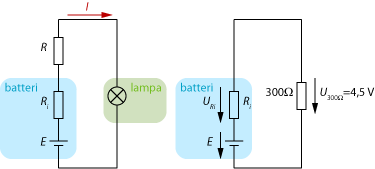Processing Math: Done
Lösning 4.2:1
FörberedandeFysik
(Skillnad mellan versioner)
| Rad 4: | Rad 4: | ||
<math>E = 4,8 V</math> Då batteriet belastas med <math>300\Omega</math> blir <math>U = 4,5 V</math><br\> | <math>E = 4,8 V</math> Då batteriet belastas med <math>300\Omega</math> blir <math>U = 4,5 V</math><br\> | ||
| + | |||
Kirchhoffs lag ger <math>4,8-R_i\cdot I-300\cdot I = 0</math> och <math>300\cdot I = 4,5 \Rightarrow</math> | Kirchhoffs lag ger <math>4,8-R_i\cdot I-300\cdot I = 0</math> och <math>300\cdot I = 4,5 \Rightarrow</math> | ||
| - | <math>I = 0,015 A \Rightarrow R_i = 20\Omega</math> Kirchoffs lag för kretsen med | + | <math>I = 0,015 A \Rightarrow R_i = 20\Omega</math><br\> |
| + | |||
| + | Kirchoffs lag för kretsen med | ||
lysdiod <math>4,8-20·0,02 - R\cdot 0,02-3,6 = 0 \Rightarrow R = 40\Omega</math> | lysdiod <math>4,8-20·0,02 - R\cdot 0,02-3,6 = 0 \Rightarrow R = 40\Omega</math> | ||
Versionen från 20 januari 2010 kl. 14.04
 8V
8V
 5V
5V
Kirchhoffs lag ger  8−Ri
8−Ri I−300
I−300 I=0
I=0 I=4
I=4 5
5
 015A
015A Ri=20
Ri=20
Kirchoffs lag för kretsen med
lysdiod  8−20·0
8−20·0 02−R
02−R 0
0 02−3
02−3 6=0
6=0 R=40
R=40

